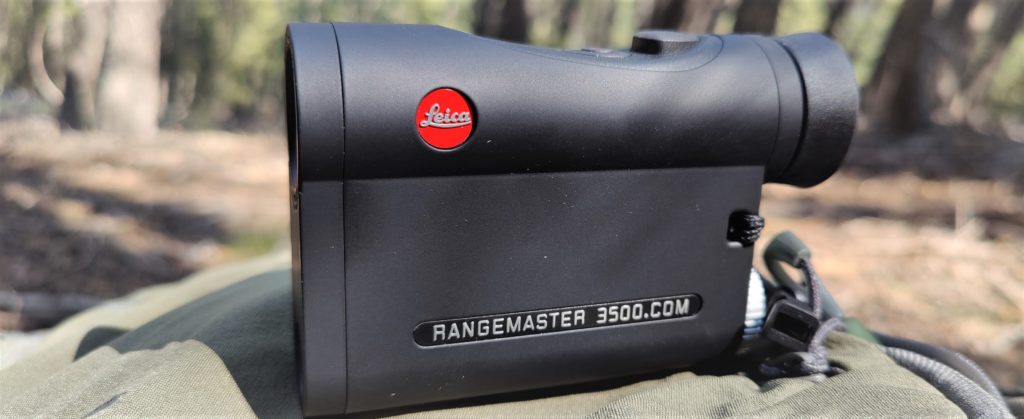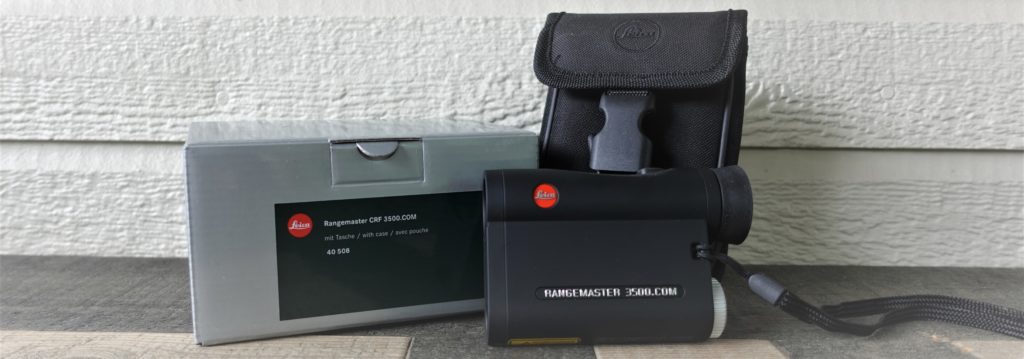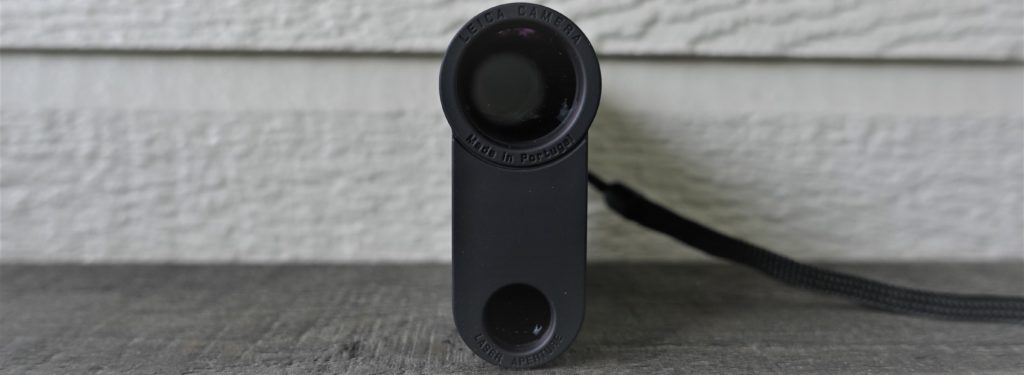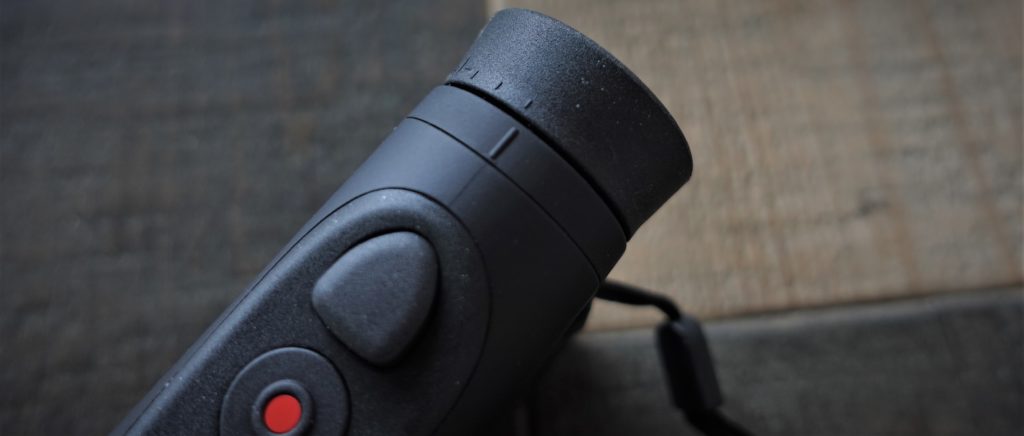If you are looking for the best rangefinder for hunting, you’ve likely considered Leica. This Leica 3500.com review was definitely on the radar with the release of this new Leica rangefinder to see how this thing performed in the field. It’s no secret that Leica Optics make some amazing rangefinders, binoculars and spotting scopes, but field testing is really where we find the pros and cons.
Check out our other rangefinder review (no Leica in that one though), where we put these other 5 rangefinders side by side!
Looking for a spotting scope? Check out our MASSIVE SPOTTING SCOPE REVIEW where we put 19 of the best spotting scopes side by side!
Looking for a binoculars? Check out our MASSIVE 26 BINOCULAR REVIEW where we put 26 of the best binoculars side by side!
leica 3500.com Review: The Testing
As we typically do here at Backwoods Pursuit, we field tested the Leica 3500.com rangefinder over the course of many months, including during the archery and rifle hunting seasons here in Idaho. During the summer, I used the Leica 3500.com on many 3D archery shoots as well as while dialing in my rifles for the hunting seasons. These various conditions, situations, and uses really gave us a good feel for where the Leica 3500.com excelled, and where it could improve.
Another part of testing for this Leica 3500.com review was to see how the applied ballistics setup worked in conjunction with the Leica App. Having a rangefinder that can spit out your holdover after calibrating it for the rifle you are shooting is a pretty handy feature.
The Specs: Leica 3500 Rangefinder Review
The Leica 3500.com rangefinder features some impressive specs, particularly concerning its weight and small size. At just 6.7 oz, the Rangemaster 3500.com is feather-light but rich on performance.
Here are some of its specs and features:
- Weight – 6.7oz
- LED red display
- True-Range angle compensation technology
- Scan gives 2 ranges per second
- Angle compensation
- Outside temperature sensor & reading
- Barometric pressure sensor
- Adaptive brightness display
- Ballistic data display
- Small & compact
- 7x magnification
- Crystal clear display
- Magnesium & Carbon fiber housing
Its crisp, clear, clean display, ease of use, and its unreal optical clarity really stood out. Those things combined with its compact size, super light weight, integrated ballistics, temperature and barometric pressure sensors as well as its built in temperature reading, all make this thing one incredible rangefinder. Most people I let use it said, Dang, that’s the best rangefinder I’ve ever used. It would be hard to disagree with that!
The Buttons: Leica 3500.com Review
One thing that I love in a rangefinder is simplicity. While the the Leica 3500.com is certainly not simple in technology, it is very simple to use and extremely effective. While this thing takes into account the incline, temperature, and atmospheric pressure to determine the most accurate range for you, all you see is the range it spits out. The primary button is much more prominent and easy to find with your finger, and one push of the button turns the unit on.
The second button (the one with the red on it) is used to display the incline, temperature, and atmospheric pressure used to calculate the range. You can see all three of those by pushing the secondary red button whenever you want, and the Leica 3500.com will cycle through those three, each displaying for about 2 seconds. I found this useful if I wanted a quick check on the outside temperature.
The Optics: Leica 3500.com Review
As you would expect from Leica’s top-of-the-line rangefinder, the optics are unreal! (I struggled a bit to get great pictures through the rangefinder though, so the optics are much better than the picture above). I’ve tested a number of rangefinders with great optics like the Leupold Full Draw 4, as well as the Vortex Razor HD 4000, the Sig Kilo 2400 ABS, and the GPO Rangetracker 1800, but not one of those matches the optical performance of this Leica Rangemaster 3500.com. This thing is phenomenal and is more like looking through a top tier binocular than a rangefinder.
I was blown away. It has unbelievable edge-to-edge clarity and is much brighter than anything else I’ve tested by a long shot with the clearest image of any rangefinder I’ve tested thus far as well. When you pair the optical performance with a red adaptive LED display that is not just crisp, but super clean and uncluttered, it’s impossible not to love what the Leica 3500.com offers you optically!
The Display: Leica 3500.com Review
I LOVE the display on the Leica 3500.com. It’s simple and clean with a red reticle that features adaptive brightness to match the brightness outside. Rangefinders that don’t have an adaptive display can be frustrating because it seems like the display is always too bright or not bright enough. This is not so with the Leica 3500.com. It also doesn’t have a bunch of unnecessary information cluttering up the display, just a simple yardage with the mode you are in. Of course if you are using the ballistics function, you’ll see the hold over or number of MOA/MIL clicks depending on how you set it up. Nothing you don’t need and everything you need to make the shot.
Field Testing – Functionality: Leica 3500.com Review
One of the big things you look at when selecting a rangefinder is its in-the-field functionality. Was it designed with real world situations we face in mind? This is where this Leica 3500.com review got a little interesting. As we previously mentioned, the optics and display are absolutely top-tier. There are, however, a few puzzling things about the way the Leica 3500.com operates.
First, the Rangemaster 3500.com is lightening fast in returning the range, all the way out to 2,700 yards off hand for me, so there is no complaint at all there. However, it is a little slower when you want to range multiple times, one after the other. For some reason, once the Leica 3500.com displays the range for you, it takes about 1.5 seconds before the reticle reappears and allows you to range again. I know I’ve found myself in the field with an animal coming in trying to rapidly range as many trees as possible, and that extra second could make a difference, and not in a good way.
I really wish the unit reset quickly and allowed follow up ranges much faster, as it feels a bit clunky that way. I suspect that the length it takes to reset is part of the extra measures the Rangemaster 3500.com takes into account when calculating the range (the temperature and atmospheric pressure) that most other rangefinders do not.
You kind of get used to the slower operating speed for follow up ranging, but if you’re coming from something like the Sig Kilo 2400 ABS, the Leupold Full Draw 4, the Bushnell Nitro 1800, or the GPO Rangetracker 1800, the difference is noticeable. I found myself clicking the range button multiple times trying to confirm my range before the Leica 3500.com would actually allow a follow up range. Kinda of a bummer.
Scan Mode: Leica 3500.com Review
The Leica 3500.com features a nice scan mode that allows you to obtain about 2 ranges per second. That’s plenty for practical use out in the field. It’s not nearly as fast as the Sig Kilo 2400 ABS we tested, but still plenty fast.
One issue I had with the scan feature is similar to the issue above in getting a follow up range. It takes a bit longer for the Leica 3500.com to switch to scan mode than with other rangefinders. It takes holding the range button down for 2.5 seconds before the unit switches to scan mode. That’s definitely on the long side, and feels like forever when you have a screaming bull elk coming in and you need as many ranges as possible before he shows up. The unit does scan nicely and pushes out roughly 2 ranges per second, but again it takes some time to switch to scan mode.
Angle Compensation (EHR): Leica 3500.com Review
For this Leica 3500.com review we tested out the “Equivalent Horizontal Range” or EHR as Leica calls it. It’s designed to give you the angel compensated range for your archery hunts, or if you want the angle compensated range for a rifle hunt. I tested it next to my Leupold Full Draw 4 at multiple 3D archery shoots, and found that it was generally within a yard or two of the Full Draw 4. It’s not ideal for the bow hunter because of the reason below, but good enough.
One huge downside of the Leica 3500.com for the bow hunter is that the angle compensated range displays AFTER the line of sight reading in the display. To see the angle compensated range, you have to put the unit in the EHR mode. You’ll first see the line of sight followed by the EHR reading about 1.5 seconds later.
Really, this is the main downside that keeps this rangefinder from being perfect for the bow hunter AND rifle hunter. When I’m archery hunting, I only care to see the angle compensated range, so having to wait for it to cycle through the line of sight, THEN display the angle compensated range is a bummer. If Leica added a “bow mode” for the 3500.com at least giving the option to have just the angle compensated range display, this would be the one and only rangefinder you’d ever need for long range shooting to short range archery shots. With that being said, it still works just fine for the archer, it’s just not ideal.
In hand Feel: Leica 3500.com Review
The Leica 3500.com is an incredibly comfortable rangefinder to use. It’s sleek, not bulky, and very light weight. It’s hard to believe Leica packed so much into this thing. It has an absolutely fantastic feel in hand. I also really love how comfortable the eye cup is and that the diopter didn’t unintentionally move on me. Again, an amazing design from Leica!
Leica Ballistic Integration: MOA, MIL, & Holdover Display Options
It seems like more and more rifle scope and rangefinder manufacturers these days have an app that pairs with the scope and/or the rangefinder via a Bluetooth connection. The Leica 3500.com is no different here. One thing I did find distinguishable from others which is very useful, is the ability to change the settings of the rangefinder unit through the app, which was very cool.
For instance, if I wanted to change the ballistic profile I wanted displayed on the unit itself I’d have to cycle through all of the settings, whereas once I’ve gotten the unit paired with my phone, I can make the change on the Leica App and it changes the setting on the 3500.com. Super cool and much easier. At times the app can be a little finicky to get synced up. It disconnects from the unit once the unit powers off, so if you are making a bunch of changes, it can be a little frustrating.
You can either select from one of the predetermined ballistic curves that Leica has programed into the unit or create your own by putting in your ballistic data, either from your custom reloads or factory off the shelf ammunition. The app will then create a custom curve for you and sync with your 3500.com unit.
Ballistic Setup Note: One thing to note when setting up your ballistic profiles is to make sure you are setting it at zero degrees elevation and 59 degrees Fahrenheit. If you set it up at, say, your anticipated elevation when hunting and an anticipated temperature, the unit will spit out a holdover or MOA assuming an altitude of zero and adjust for the temperature, so it’ll double count the elevation and temperature and could cause an inaccurate reading.
MOA, MIL & Holdover Display Options
The Leica Rangemaster 3500.com rangefinder gives you multiple options on how you can have the ballistic data displayed: EHR (Equivalent Horizontal Range only), Holdover (in inches or meters), the MOA’s in absolute values (i.e. 5.5 MOAs), number of clicks in either 1/4 or 1/3 MOA per click (i.e. 25 clicks up displayed), and holdover in 10mm or 5mm for those that use MILs. Pretty much covers most options we may need or want.
One important thing to note is that when you are using the EHR mode, the unit calculates the range based on the compensated angle range, but does not include the temperature or altitude factors. When using the any of the holdover or ballistic calculation settings, the unit takes the distance, angle, altitude, temperature and ballistics into account to display your holdover or MOA adjustment. Pretty sweet and absolutely a necessity when shooting long range.
Inclement Weather Performance: Leica 3500.com Review
I had the luxury of testing the Leica 3500.com throughout the archery and rifle seasons, seeing weather from sunny and warm to downright nasty, cold and snowy. The Rangemaster 3500.com performed flawlessly for me no matter the condition. I was particularly interested to see how it would do in rain, snow and below freezing temperatures, and it was fantastic. It still returned a range lightening fast no matter the conditions.
The only time I got it to “fail”, and that’s a strong word here, was during a snow storm where visibility was around 300 yards (and you could barley make out shapes at that range). Sometimes the laser on the Rangemaster 3500.com seemed to bounce off the heavy, wet, falling snow, giving me a range of 50-70yds, and sometimes it would get through the snow and return a range of 280-300yds. Heavy, wet snow is typically a nightmare for any rangefinder, so this was no surprise and certainly no disappointment for me.
What I liked: Leica 3500.com Review
Overall Performance
The Leica 3500.com rangefinder just might be the overall best rangefinder for hunting if you are looking for a rangefinder for everything from bow hunting to long range shooting. This thing is really built for the rifle hunter, but would be more than sufficient for the archery hunter as well. It has a few limitations for the archer that we’ll mention below, but it is still fantastic.
Size/Weight/Feel
As I mentioned earlier, I LOVE the size, weight, and in-hand feel of the Leica 3500.com rangefinder. It flat out feels great in your hand. The rubber outer isn’t thick and bulky, but gives you the grip you need while still maintaining its super light weight and feeling very well made.
Uncluttered Display
The display on the Leica 3500.com is simply perfect with a precise reticle, auto adjust brightness, red display, and a clean, uncluttered display. It’s simple and gives you what you need to know to make the shot (except for the bow hunter, which we cover below). The display of the Leica 3500 is probably my favorite of all the rangefinders I’ve tested to date.
Incredible Optics
Based on what I’d heard about the optics you get with a Leica rangefinder, I was expecting the optical performance to be great on the Leica 3500.com rangefinder. With that being said, I wasn’t expecting it to be THIS good. Multiple people who also tested it out with me commented that it’s like using a high end pair of binoculars. The optics are that good! Colors are vibrant and sharp, edge-to-edge clarity outstanding, and the clarity is unmatched by any other rangefinder I’ve tested. Simply put, the Leica Rangemaster 3500.com rangefinder is optically the finest rangefinder we’ve had the privilege of testing so far, and as close to the “perfect” all around rangefinder as we’ve found.
What I didn’t like: leica 3500.com Rangefinder
The list of things that I love about the Leica 3500.com rangefinder is long, but there are just a few things that I felt could be better:
Slow Switch To Scan Mode
How long it takes the Leica 3500.com to switch from single range mode to scan mode is a bit of a drag. You have to hold the button down for a whopping 2.5 seconds before it switches over. That’s simply too long in my opinion. How big of a deal is it? Well, that’s up to you, but it sure is a far cry from others I’ve tested that switch to scan mode in about half the time. 2.4 seconds feels like a long time, particularly in the type of situations you’d likely want to use the feature.
ELR Mode Not Archery Friendly
Another feature that I wish the Leica 3500.com has is a bow mode. Yes, you can use the ELR and still get an angle compensated range, but it’s problematic and the readout is again just too slow for the archery hunter. So many rangefinders have both bow and rifle modes these days, so it’s very perplexing why Leica didn’t build archery specific mode into the 3500.com.
The EHR mode would even be fine for the bow hunter if the angle compensated range was the first number to display, but as it functions, you first get the line of sight range, then have to wait 1.5 seconds to get the angle compensated range. Again, that feels like an eternity if you are ranging an animal within bow range and need to know the angle compensated distance of your shot right away. For that reason, I hesitate to take the Leica 3500.com into the field as my rangefinder for archery hunting, as hard as that is to say.
Slow Response for Follow Up Ranges
One last complaint I have about the Leica 3500.com after using this in the field is how long it takes to be able to get a follow up range. Even though the ranging speed is super fast, there is a pause of about 1.5 seconds after the range displays before it allows you to range again. Maybe it’s just me, but I like to range that tree or animal multiple times to make sure before I let the arrow fly or dial in the rifle scope. It just takes too long to be able to get that follow up range with the Leica 3500.com.
The alternative would be to use the scan mode, but it takes the 2.5 seconds for the unit to switch to scan mode. So, it’s kind of a tough deal. Better make sure you get the range you want on the first try or you’ll be waiting to get your follow up range.
Leica 3500.com Rankings
Weight
Reticle/Display
Ranging Speed
Ease of Use
Optical Quality
Price Point
Overall Ranking
Leica 3500.com Review: Conclusion
Yes, there are a few things that are a disappointment, but I walked away from testing the Leica 3500.com for this review saying, This thing is awesome! It’s easy to set up, simple to read, has a red display that is adaptive to the light conditions you are in, and has the absolute BEST optics I’ve found in a rangefinder. It even integrates your rifle ballistics and can be paired with a Kestrel for your long range shooting.
It’s SO close to the perfect all-around rangefinder, which makes the lack of an archery friendly setup painful. If it did have a archery mode, this would be the only rangefinder any type of hunter would ever need. Period. Yeah, the price point is way up there at $1,199, but you do get what you pay for in this gem of a rangefinder.
Subscribe to Backwoods Pursuit to get Your FREE Backcountry Gear Worksheet!!!
Dial in your gear list, calculate your pack weight, and lighten up your pack with this handy tool!





















